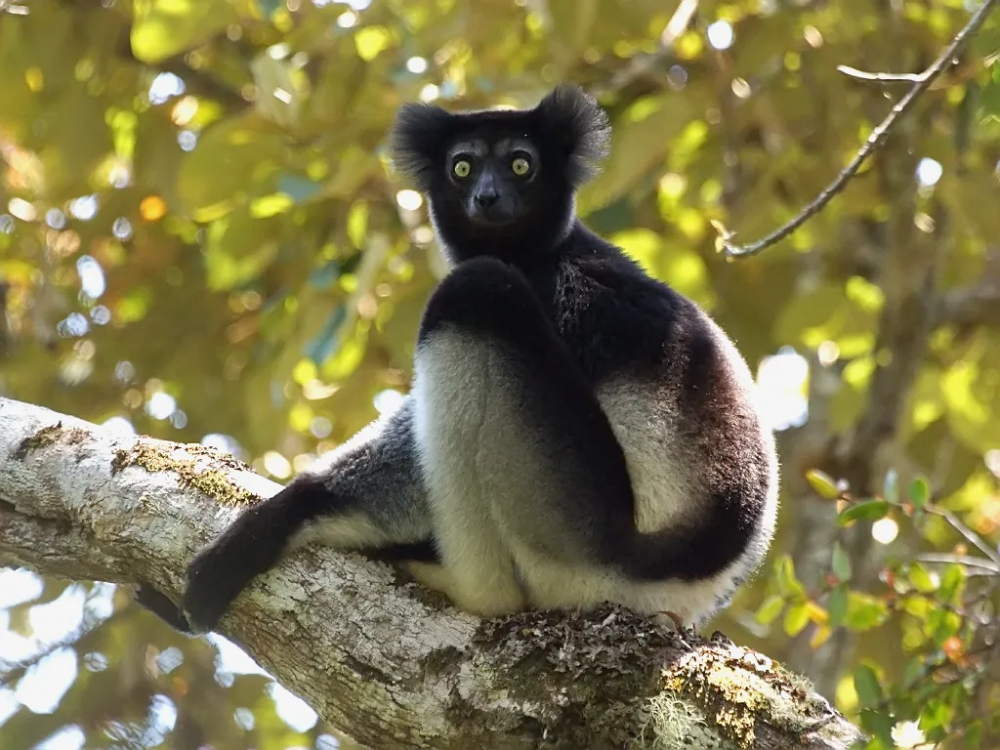In the lush rainforests of Madagascar, where biodiversity thrives in unparalleled splendor, one creature reigns supreme: the indri. With its haunting calls echoing through the dense canopy and its enigmatic presence, the indri captures the imagination of all who encounter it. As the largest of Madagascar’s lemurs and one of the most critically endangered, the indri stands as a symbol of the island’s unique and fragile ecosystem.
The indri (Indri indri) belongs to the lemur family, a group of primates found only on the island of Madagascar. With its distinctive black and white coloration and large, expressive eyes, the indri is instantly recognizable. Adults can weigh up to 9.5 kilograms (21 pounds) and reach lengths of over 70 centimeters (28 inches), making them the largest extant lemurs.
Habitat and Distribution
Endemic to the eastern rainforests of Madagascar, the indri inhabits a narrow strip of land stretching from the Andasibe-Mantadia National Park to the Masoala Peninsula. These forests, characterized by dense vegetation and high rainfall, provide the indri with the perfect habitat for its arboreal lifestyle. However, deforestation and habitat fragmentation pose significant threats to the indri’s survival, limiting its range and putting pressure on its population.

Behavior and Social Structure
Indris are primarily arboreal, spending the majority of their time in the treetops where they feed on leaves, flowers, and fruit. Unlike many other lemur species, indris are diurnal, meaning they are active during the day. They live in small family groups consisting of a mated pair and their offspring, typically numbering between three to five individuals. These groups communicate through a series of distinctive calls, including the iconic “singing” duets performed by mating pairs.
Vocalizations and Communication
One of the most fascinating aspects of indri behavior is their vocal repertoire. Their haunting calls, reminiscent of whale songs, carry for long distances through the forest. These calls serve multiple purposes, including territory defense, mate attraction, and group cohesion. Researchers have identified several distinct vocalizations, each with its own meaning and function within indri society. Studying these vocalizations provides valuable insights into the social dynamics and behavior of these elusive primates.
Conservation Status and Threats
Despite their cultural significance and ecological importance, indris face numerous threats to their survival. Habitat loss due to deforestation, logging, and slash-and-burn agriculture poses the greatest threat to their populations. Additionally, hunting and poaching, fueled by the illegal pet trade and traditional beliefs, further exacerbate their decline. As a result, the International Union for Conservation of Nature (IUCN) lists the indri as critically endangered, with populations decreasing rapidly in recent years.
Conservation Efforts
Efforts to conserve the indri and its habitat are underway, led by local communities, conservation organizations, and government agencies. Protected areas such as national parks and reserves play a crucial role in safeguarding their populations and their habitat. Community-based conservation initiatives, focused on sustainable livelihoods and ecotourism, aim to alleviate pressure on forests while providing economic opportunities for local communities. Education and awareness programs seek to foster appreciation for the indri and promote conservation efforts among the public.
The Importance of Indri Conservation
Protecting the indri is not only essential for preserving Madagascar’s unique biodiversity but also for maintaining the health and integrity of its ecosystems. As seed dispersers and pollinators, indris play a vital role in forest regeneration and ecosystem function. Their decline could have cascading effects on plant diversity, soil fertility, and the overall stability of Madagascar’s forests. By conserving the indri, we not only safeguard a charismatic species but also protect the rich tapestry of life that defines Madagascar.
Conclusion
The indri stands as a symbol of Madagascar’s natural heritage, embodying the beauty, diversity, and fragility of its ecosystems. As we strive to conserve this iconic species, we must also address the underlying drivers of its decline, including habitat destruction, hunting, and climate change. By working together, we can ensure a future where the haunting calls of the indri continue to echo through the forests of Madagascar, a testament to the resilience of nature and the power of conservation.









